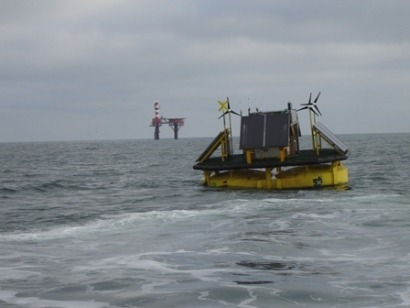
A full-size prototype of the floating LIDAR (Light Detection And Ranging) offshore resource assessment system, known as FLIDAR (Floating Light Detection And Ranging)), has been successfully tested 15 kilometres off the Belgian coast. It was located next to a stationary LIDAR (WINDCUBE®v2 LIDAR from Leosphere) on a fixed communication mast during October, in order to test survivability and validate the accuracy of the wind speed measurements.
This is the first successful trial of a floating LIDAR device in real offshore conditions in the North Sea. Designed to withstand significant wave heights of over 6 metres the FLIDAR system was tested in wind speeds up to 25 m/s and proved highly accurate, with an r2 of over 0.99 when compared to reference LIDAR data. “The recent tests have proven that the FLIDAR system can offer the fastest, most cost-effective, accurate offshore wind resource assessments”, said Bruce Douglas, Sales and Marketing Director at 3E.
The profitability of offshore wind farms depends heavily on the ability to predict and deliver maximum power output at competitive costs. Reaching this optimum first requires an in-depth knowledge of the wind resource.
As the wind resource is the primary energy source of any offshore wind farm, its precise assessment is of great importance. Furthermore, as the behaviour of the wind has an impact on nearly all the components of a wind farm, a wrong estimation of some parameters (especially turbulence, gusts, extreme wind speed and wind speed distribution) may impact the performance of the turbines, the component lifetime or even the structural integrity of the turbines. Both short term and long term characteristics of the wind and the corresponding predictability are important.
Until now, building fixed measurement masts at sea equipped with standard anemometers or LIDAR systems was necessary to ensure successful measurements offshore. The construction of this type of infrastructure requires extensive permitting and can cost ®3 - 8 million.
However, the successful sea trials of the FLIDAR is intended to significantly reduce these prohibitive costs and provide more flexibility for wind power developers and asset managers.
The FLIDAR was developed by global renewable energy consultant 3E, and Offshore & Wind Assistance NV, a 100% subsidiary of the Belgian geotechnical offshore contractor GeoSea, as part of the Offshore Wind Infrastructure project co-financed by the Flemish Government.
It is made up of an industry standard buoy adapted to marine regulations for faster permitting. The world leading Leosphere WINDCUBE®v2 Offshore LIDAR device is secured on top of a mechanical stabilisation system whilst a set of PV panels, small wind turbines and battery pack provide independent power supply. Data is retrieved and communicated via satellite to a web based monitoring and reporting tool. The results can also be coupled with a wind farm simulation model to allow real time analysis of key performance indicators for wind turbine energy conversion.
The FLIDAR system will be launched at a press conference at the upcoming EWEA offshore event at 10:00 on 30 November in Amsterdam (The Netherlands).
For additional information:

